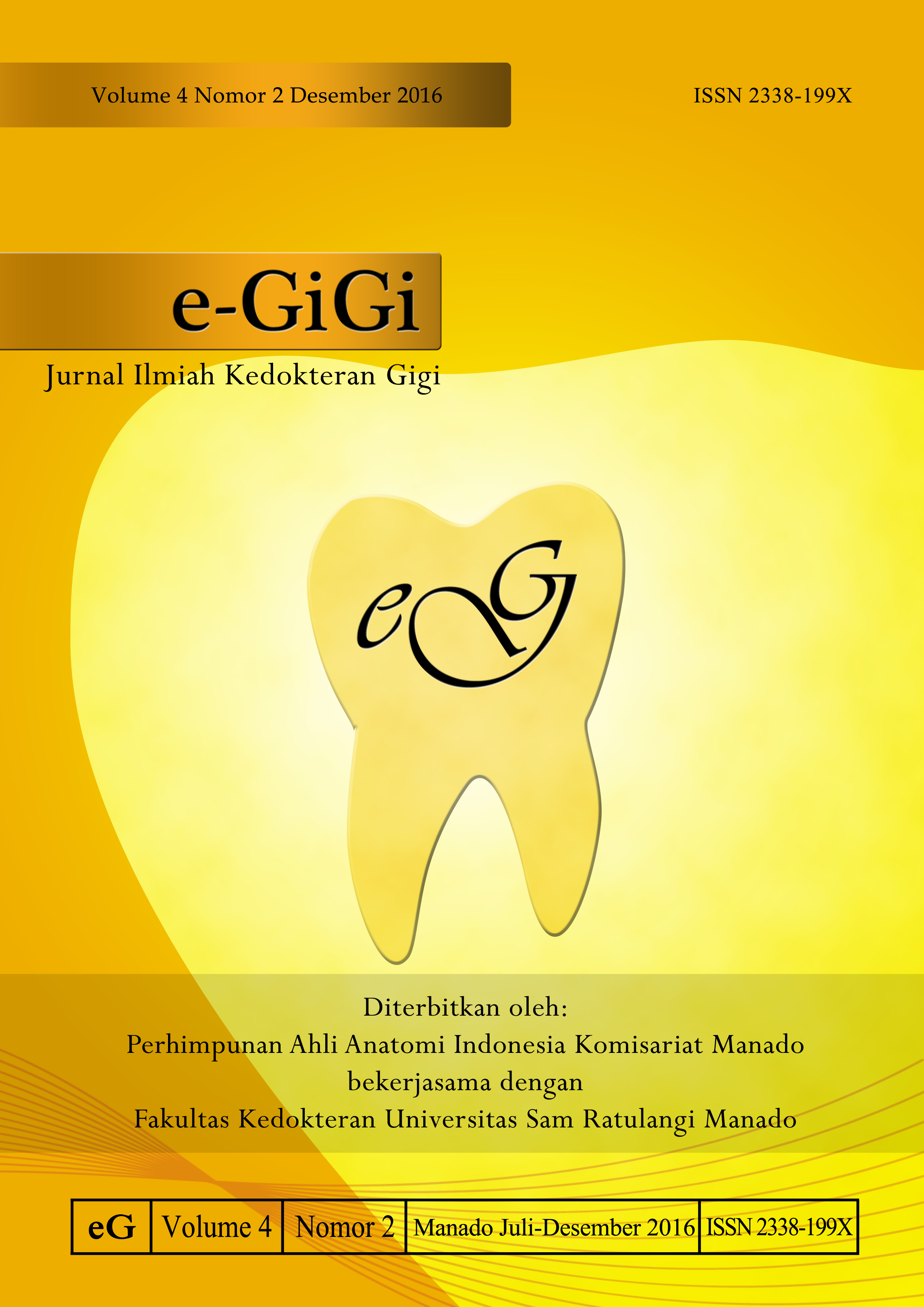Pengaruh tingkat pendidikan masyarakat terhadap upaya pemeliharaan gigi tiruan di Kelurahan Upai Kecamatan Kotamobagu Utara
DOI:
https://doi.org/10.35790/eg.4.2.2016.14158Abstract
Abstract: Denture appliances is not just as a replacement for any kind of tooth loss but it is also a necessary to keep the hygiene and maintenance of the denture appliance, therefore, the denture appliances will not cause any bad effects on oral health. Knowledge of how to keep the denture appliance clean could be represented by a positive attitude through cleaning one’s denture appliance. This study was aimed to analyze the effect of education level on the maintenance efforts of denture appliances among denture users in Upai, North Kotamobagu.This was an analytical descriptive study with a cross-sectional design. Samples were obtained by using total sampling method. The instrument of this study was a valid and reliable questionnaire. Data were analyzed with the Chi-Square test. This study was conducted from February to August 2016. The results showed that 41.9% of the samples had moderate level of education; 47.1% had low education; and 11% had high education. In keeping their denture appliances clean, there were 74.2% that had moderate efforts; 13,6% had bad efforts; and 12.2% had good efforts. The Chi-square test showed a p value of 0.001 (p<0.05). Conclusion: Most of the denture users were low-level educated, however, most of them had moderate efforts in keeping their dentures clean.
Keywords: education level of society, maintenance efforts of denture appliances.
Â
Abstrak: Penggunaan gigi tiruan tidak hanya sebatas penggantian gigi yang hilang tetapi harus memperhatikan pemeliharaan kebersihannya agar tidak berdampak buruk bagi kesehatan rongga mulut. Pengetahuan yang baik dari masyarakat akan membentuk sikap positif dan diwujudkan melalui tindakan pemeliharaan gigi tiruan. Penelitian ini bertujuan untuk menganalisis pengaruh tingkat pendidikan masyarakat terhadap upaya pemeliharaan gigi tiruan di Kelurahan Upai Kecamatan Kotamobagu Utara. Jenis penelitian ialah deskriptif analitik dengan desain potong lintang. Populasi penelitian yakni masyarakat pengguna gigi tiruan lepasan (GTL) di Kelurahan Upai Kecamatan Kotamobagu Utara sebanyak 155 orang. Teknik pengambilan sampel menggunakan metode total sampling. Instrumen penelitian berupa kuesioner yang telah dilakukan uji validitas dan reliabilitas. Analisis hasil penelitian digunakan uji statistic Chi-Square. Hasil penelitian menunjukkan 41,9% masyarakat kelurahan Upai memiliki tingkat pendidikan sedang, 47,1% memiliki tingkat pendidikan rendah, dan 11% memiliki tingkat pendidikan tinggi. Terdapat 74,2% memiliki upaya yang cukup dalam pemeliharaan gigi tiruan, 13,6% buruk, dan 12,2% baik. Hasil uji Chi Square mendapatkan p=0,001 (p<0,05). Simpulan:: Tingkat pendidikan masyarakat pengguna gigi tiruan umumnya tergolong rendah tetapi memiliki upaya yang cukup dalam pemeliharaan gigi tiruan. Juga terdapat pengaruh bermakna dari tingkat pendidikan masyarakat terhadap upaya pemeliharaan gigi tiruan.
Kata kunci: tingkat pendidikan masyarakat, upaya pemeliharaan gigi tiruan.
Downloads
Published
How to Cite
Issue
Section
License
COPYRIGHT
Authors who publish with this journal agree to the following terms:
Authors hold their copyright and grant this journal the privilege of first publication, with the work simultaneously licensed under a Creative Commons Attribution License that permits others to impart the work with an acknowledgment of the work's origin and initial publication by this journal.
Authors can enter into separate or additional contractual arrangements for the non-exclusive distribution of the journal's published version of the work (for example, post it to an institutional repository or publish it in a book), with an acknowledgment of its underlying publication in this journal.
Authors are permitted and encouraged to post their work online (for example, in institutional repositories or on their website) as it can lead to productive exchanges, as well as earlier and greater citation of the published work (See The Effect of Open Access).






